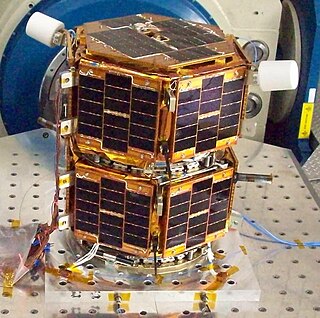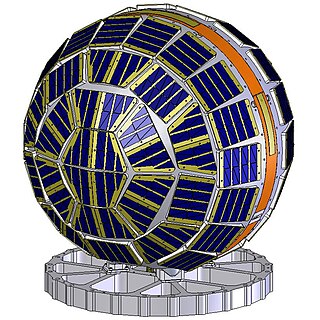Related Research Articles

A CubeSat is a class of miniaturized satellite with a form factor of 10 cm (3.9 in) cubes. CubeSats have a mass of no more than 2 kg (4.4 lb) per unit, and often use commercial off-the-shelf (COTS) components for their electronics and structure. CubeSats are put into orbit by deployers on the International Space Station, or launched as secondary payloads on a launch vehicle. As of August 2021, more than 1,600 CubeSats have been launched.

The Air Force Research Laboratory (AFRL) is a scientific research and development detachment of the United States Air Force Materiel Command dedicated to leading the discovery, development, and integration of direct-energy based aerospace warfighting technologies, planning and executing the Air Force science and technology program, and providing warfighting capabilities to United States air, space, and cyberspace forces. It controls the entire Air Force science and technology research budget which was $2.4 billion in 2006.

A small satellite, miniaturized satellite, or smallsat is a satellite of low mass and size, usually under 1,200 kg (2,600 lb). While all such satellites can be referred to as "small", different classifications are used to categorize them based on mass. Satellites can be built small to reduce the large economic cost of launch vehicles and the costs associated with construction. Miniature satellites, especially in large numbers, may be more useful than fewer, larger ones for some purposes – for example, gathering of scientific data and radio relay. Technical challenges in the construction of small satellites may include the lack of sufficient power storage or of room for a propulsion system.
The Space Test Program (STP) is the primary provider of spaceflight for the United States Department of Defense (DoD) space science and technology community. STP is managed by a group within the Advanced Systems and Development Directorate, a directorate of the Space and Missile Systems Center of the United States Space Force. STP provides spaceflight via the International Space Station (ISS), piggybacks, secondary payloads and dedicated launch services.
The Israeli Nano Satellite Association was set up in Israel in 2006, with the aim of promoting the use of nanosatellites.
The Cornell University Satellite (CUSat) is a nanosatellite developed by Cornell University that launched on 29 September 2013. It used a new algorithm called Carrier-phase Differential GPS (CDGPS) to calibrate global positioning systems to an accuracy of 3 millimeters. This technology can allow multiple spacecraft to travel in close proximity.

Formation Autonomy Spacecraft with Thrust, Relnav, Attitude and Crosslink is a pair of nanosatellites developed and built by students at The University of Texas at Austin. The project is part of a program sponsored by the Air Force Research Laboratory (AFRL), whose goal is to lead the development of affordable space technology. The FASTRAC mission will specifically investigate technologies that facilitate the operation of multiple satellites in formation. These enabling technologies include relative navigation, cross-link communications, attitude determination, and thrust. Due to the high cost of lifting mass into orbit, there is a strong initiative to miniaturize the overall weight of spacecraft. The utilization of formations of satellites, in place of large single satellites, reduces the risk of single point failure and allows for the use of low-cost hardware.

DANDE is a 50 kg class spacecraft developed by the University of Colorado Boulder was the winner of the 5th iteration of the Air Force Research Laboratory's University Nanosat Program.

The Nanosat-1B Spanish satellite, designed, developed and operated by the Instituto Nacional de Técnica Aeroespacial (INTA), is a nanosatellite which weighs 22 kg. Its main mission is the communication between remote sites like the Antarctic, the Hespérides warship and Spain. The Nanosat-1B has fourteen sides, all of them covered by solar cells but the bottom one where the following antennas are installed: a medium gain Ultra high frequency (UHF) four wire antenna and two patch antennas. On the top side there are four UHF monopoles. The solar sensors and the Vectorsol experiment are located in the middle tray, being all the other equipment and experiments located inside the satellite.

The NASA Launch Services Program (LSP) is responsible for procurement of launch services for NASA uncrewed missions and oversight of launch integration and launch preparation activity, providing added quality and mission assurance to meet program objectives. LSP operates under the NASA Space Operations Mission Directorate (SOMD).
Technology Education Satellite (TechEdSat) is a successful nano-sat flight series conducted from the NASA Ames Research Center in collaboration with numerous universities. While one of the principal aims has been to introduce young professionals and university students to the practical realm of developing space flight hardware, considerable innovations have been introduced. In addition, this evolving flight platform has tested concepts for Low Earth Orbit (LEO) sample return, as well as planetary nano-sat class mission concepts.

Busek Co. Inc. is an American spacecraft propulsion company that builds thrusters, electronics, and various systems for spacecraft.

Antares A-ONE mission was the maiden flight of Orbital Sciences Corporation' Antares launch vehicle including the ascent to space and accurate delivery of a simulated payload, the Cygnus Mass Simulator (CMS), which was launched 21 April 2013. It was launched from Pad 0A at the Mid-Atlantic Regional Spaceport (MARS), Wallops Flight Facility, Virginia. The simulated payload simulates the mass of the Cygnus cargo spacecraft. This dummy payload was sent into an orbit of 240 km × 260 km with an orbital inclination of 51.6°, the same launch profile it will use for Orbital's upcoming cargo supply missions to the International Space Station (ISS) for NASA.

PhoneSat is an ongoing NASA project of building nanosatellites using unmodified consumer-grade off-the-shelf smartphones and Arduino platform and launching them into Low Earth Orbit. This project is part of NASA's Small Spacecraft Technology Program and was started in 2009 at NASA Ames Research Center.

The Nanoracks CubeSat Deployer (NRCSD) is a device to deploy CubeSats into orbit from the International Space Station (ISS).

Lunar IceCube is a NASA nanosatellite orbiter mission that was intended to prospect, locate, and estimate amount and composition of water ice deposits on the Moon for future exploitation. It was launched as a secondary payload mission on Artemis 1, the first flight of the Space Launch System (SLS), on 16 November 2022. As of February 2023 it's unknown whether NASA team has contact with satellite or not.

LunIR is a nanosatellite spacecraft launched to the Moon collecting surface spectroscopy and thermography. It was launched as a secondary payload on the Artemis 1 mission on 16 November 2022.
The University of Georgia Small Satellite Research Laboratory (SSRL), or UGA SSRL, is a research laboratory founded in late 2015 with the goal of launching a student-built spacecraft into low Earth orbit. The SSRL is currently building the University of Georgia's first two satellites. The lab has a Space Act Agreement with the NASA Ames Research Center.

Cosmic X-ray Background Nanosatellite-2 was a satellite and mission developed by the Morehead State University to follow up on the CXBN mission launched in 2012. It was an improved version of the previous spacecraft and it increased the precision of measurements of the cosmic X-ray background in the 30-50 keV range and helped to improve understanding of the early universe.
References
- ↑ US Air Force. "University Nanosatellite Program". AFRL. Retrieved 2008-06-22.
- 1 2 3 4 "University Nanosat Program" (PDF). September 2011. Retrieved February 4, 2023.
- ↑ "About the University Nanosatellite Program". universitynanosat.org. Retrieved February 4, 2023.
- 1 2 3 NASA Jet Propulsion Laboratory. "Three Corner Satellite". NASA. Archived from the original on 2001-06-05. Retrieved 2008-07-13.
- ↑ "Delta 4-Heavy investigation identifies rocket's problem" . Retrieved 2014-01-30.
- ↑ Torres, Juliana (2005-01-21). "Students' satellites win right to space flight". The Daily Texan. Archived from the original on 2009-06-18. Retrieved 2008-07-13.
- ↑ Horan, Stephen; Stochaj, S.; Alvarez, L.; Ege, W.; Romero, V.; Zamarron, F.; Boehmer, C.; Cecil, J.; Clark, J.; Guyer, G.; Johnson, E.; Ranade, S.; Riley, L. (August 2003). "The New Mexico State University Satellite (NMSUSat) Mission". Small Satellite Conference 2003. Retrieved February 4, 2023.
- ↑ "FASTRAC satellites survive orbit". University of Texas. February 24, 2011. Retrieved February 4, 2023.
- ↑ "Cornell University Chosen To Build Nanosat-4 Flight Experiment". spacedaily.com. April 4, 2007. Retrieved February 4, 2023.
- ↑ "CUSat, launched Sept. 29 2013". Cornell University. October 28, 2013. Retrieved February 4, 2023.
- ↑ "DANDE Launches: Students Engaged in Mission Operations" (PDF). Colorado Communicator. Retrieved February 4, 2023.
- 1 2 3 "Nanosat-6 Flight Competition Review winners announced and Nanosat-7 Competition begins". Air Force Office of Scientific Research. Retrieved 4 March 2011.
- ↑ Goodrich, Marcia (January 20, 2011). "Blast Off! Tech Students' Winning Satellite to Be Launched into Orbit". Michigan Technological University. Retrieved February 4, 2023.
- ↑ Moline, Tom; Gardner, Wesley (Summer 2012). "SCARAB:Integration of the COPPER and Argus Spacecraft" (PDF). Retrieved February 5, 2023.
- ↑ Raven, Benjamin (June 26, 2019). "Satellite built by Michigan Tech students launches into space aboard Falcon Heavy rocket". mlive.com. Retrieved February 4, 2023.
- ↑ Krebs, Gunter D. "Prox 1 (Nanosat 7)". Gunter's Space Page. Retrieved February 5, 2023.
- ↑ "BUSat". Boston University. Retrieved February 5, 2023.
- ↑ "Argus: Space Radiation on Modern Electronics". St. Louis University. Retrieved February 5, 2023.
- ↑ "AFRL announces winners of student satellite competition". AFRL. February 2, 2015. Retrieved February 4, 2023.
- ↑ Ehrhard, Peter (January 30, 2015). "Missouri S&T satellite team wins national Air Force competition". Missouri S&T University. Retrieved February 4, 2023.
- ↑ "RECONnaissance of Space Objects". Georgia Tech. Retrieved February 5, 2023.
- ↑ Nealon, Cory (February 10, 2016). "UB students to build a third space debris observation satellite". University of Buffalo. Retrieved February 4, 2023.
- ↑ Circelli, Deborah (January 13, 2013). "Embry-Riddle wins grant to design satellite". Daytona Beach News-Journal. Retrieved February 4, 2023.
- 1 2 Flurry, Alan (January 29, 2018). "UGA Satellite Team Closer to Space". Athens Banner-Herald. Retrieved February 4, 2023.
- ↑ "Student satellite team a step closer to space". Uga.edu. 25 January 2018.
- ↑ "MAXWELL - University Nanosat Program". University of Colorado - Boulder. Retrieved February 4, 2023.
- ↑ Newberry, Daniel. "Design and Testing of the Flight Computer for a SmallSat Propulsion System Testbed" (PDF). Missouri University of Science and Technology. Retrieved February 5, 2023.
- 1 2 Perkins, Joanne (November 23, 2021). "AFRL selects 10 universities for prestigious satellite program". AFRL. Retrieved February 4, 2023.
- ↑ "AFRL Selects University of Minnesota for Prestigious Satellite Program". University of Minnesota. Retrieved February 4, 2023.
- ↑ Walker, Felysha (January 24, 2022). "Texas A&M student-led satellite team prepares for space". Texas A&M University. Retrieved February 4, 2023.
- ↑ "Then There Were Three: Stratus Nanosatellite Launch for MTU's Aerospace EnterpriseKim Geiger". October 15, 2021. Retrieved February 4, 2023.
- ↑ O'Neil, Bridjes (August 26, 2021). "SLU Takes 'DORRE' Mission to National Nanosatellite Competition". St. Louis University. Retrieved February 4, 2023.
- ↑ "Space Dynamics Laboratory (SDL) Request for Proposals for the Government Fiscal Year (GFY) 2022 NS-11 University Nanosatellite Program (UNP)" (PDF). Space Dynamics Laboratory. August 9, 2021. Retrieved February 4, 2023.
- ↑ Vaskaa, C.; Mulleta, J.; Longb, J.; Thorsena, D.; Kegegeb, O.; Wongb, Y.; Luebke-Laroquea, Q.; O’Neilla, K.; Emerson, C. (May 5, 2021). "The CubeSat Communication Platform (CCP) – Mission Overview and ConOps". 16th International Conference on Space Operations, 3 - 5 May 2021. NASA. Retrieved February 4, 2023.
- ↑ "Small satellite, big mission". University at Buffalo. February 7, 2022. Retrieved February 5, 2023.
- ↑ "FLaC-Sat". Purdue University. Retrieved February 4, 2023.
- ↑ "Rutgers selected by the Airforce to build a CubeSat". Rutgers University. Retrieved February 4, 2023.
- ↑ "SERPENT (Satellite Evaluation of Relative Pose Estimation of a Non-cooperative Target)". University of Texas at Austin. Retrieved February 5, 2023.